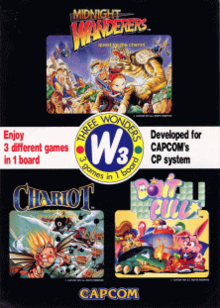Three Wonders
| Three Wonders | |
|---|---|
 Three Wonders arcade flyer | |
| Developer(s) | Capcom |
| Publisher(s) | Arcade: Capcom PS1, Saturn: Xing Entertainment |
| Director(s) | Yoshiki Okamoto |
| Designer(s) | Toshihiko Uda |
| Programmer(s) | Koma Chan |
| Composer(s) | Masaki Izutani |
| Platform(s) | Arcade, PlayStation, Sega Saturn |
| Release | Arcade May 20, 1991 PlayStation, Saturn 1998 |
| Genre(s) | Platformer, scrolling shooter, puzzle |
| Mode(s) | Single-player, multiplayer |
| Arcade system | CP System |
Three Wonders[a] is a 1991 video game collection developed and published by Capcom, originally released for the arcades using the CPS-1 platform.[1] It includes three related titles: Midnight Wanderers: Quest for the Chariot,[b] a platformer; Chariot: Adventure through the Sky,[c] a scrolling shooter; and Don't Pull,[d] a puzzle video game.
Gameplay
[edit]Midnight Wanderers
[edit]A platform game that sees the player control a hobbit named Lou and his travelling companion, Siva, to run, climb, and shoot at enemies to fight a villain who is turning their people into wooden statues.
Chariot
[edit]A scrolling shooter game featuring the characters from Midnight Wanderers flying in their chariots to save their home planet and princess.
Don't Pull
[edit]A puzzle game similar to games like the Adventures of Lolo series, Pengo, and Capcom's own puzzle game Pirate Ship Higemaru. It involves the player controlling either a rabbit named Don (Player 1) or a squirrel called Pull (Player 2), pushing blocks to crush monsters.
Development and release
[edit]Three Wonders was released in the arcades on May 20, 1991. A version for the Capcom Power System Changer was planned and previewed but never released.[2]
In 1998, it was ported to the PlayStation and Sega Saturn and published by Xing Entertainment. Three Wonders was also included in the 2006 Capcom Classics Collection Vol. 2 on the PlayStation 2 and Xbox, Capcom Classics Collection Remixed on the PSP and Capcom Arcade 2nd Stadium.
Characters from Three Wonders would go on to appear in other Capcom games. Lou appears in Marvel vs. Capcom: Clash of Super Heroes (1998) as an assist character. Siva was later adapted into the payable character Shiba Shintaro in Cannon Spike (2000).
Reception
[edit]In Japan, Game Machine listed Three Wonders on their August 1, 1991 issue as being the fifth most-successful table arcade unit of the month.[3] Retro Gamer regarded Three Wonders as a good alternative to Biomechanical Toy.[4] GameFan reviewed the PlayStation version as inferior to the original arcade game due to bad quality converted graphics.[5]
Notes
[edit]References
[edit]- ^ "Three Wonders". Hardcore Gaming 101.
- ^ "カプコン アーケードオリジナルボード CPSシリーズ+CPSチェンジャー 限定販売決定!!". Club Capcom (in Japanese). Vol. 2. Capcom. Spring 1994. pp. 90–91.
- ^ "Game Machine's Best Hit Games 25 - テーブル型TVゲーム機 (Table Videos)". Game Machine (in Japanese). No. 408. Amusement Press, Inc. 1 August 1991. p. 25.
- ^ "Converted Alternative - 3 Wonders". Retro Gamer. No. 74. Imagine Publishing. p. 20.
- ^ "R Review - Three Wonders". Retro Gamer. Vol. 6, no. 6. June 1998. p. 91.
